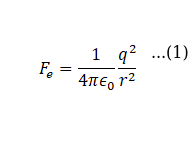Two identical balls, having a charge of 2.00 × 10–7 C and a mass of 100g, are suspended from a common point by two insulating strings each 50 cm long. The balls are held at a separation 5.0 cm apart and then released. Find
(a) the electric force on one of the charged balls
(b) the components of the resultant force on it along and perpendicular to the string
(c) the tension in the string
(d) the acceleration of one of the balls. Answers are to be obtained only for the instant just after the release.
Given,
Mass, ![]()
Length of strings, l = 50cm = 0.5 m
Distance between spheres, ![]()
Magnitude of charge on each ball, ![]()
Let the magnitude of Tension be T. Let the magnitude of electric force between the spheres be Fe.
Note that tension will adjust itself so that there is no acceleration along its direction.

(a)
___________________________________________________
Formula used:
By Coulomb’s law, the electric force is given by:
![]()
Where ϵ0 is the permittivity of free space
q1 and q2 are the magnitude of charges
r is the distance of separation between the charges
(Here, ![]() )
)
___________________________________________________
The magnitude of the electric force, Fe is given by:

![]()
Hence, the electric force is 0.144 N along the line joining the charges and away from the other charge.
(b)
By trigonometry,
![]()
![]()
Now, along the string, there is component of acceleration. Hence,
![]()
Now, consider the direction perpendicular to the string,
![]()
![]()
![]()
Hence, the component of net force perpendicular to the string is 0.095N and away from the other charge (indicated by positive sign)
(c)From the free body diagram,
![]()
Rearranging to get the above expression, we get
![]()
![]()
(d)
Applying Newton’s second law along the y-direction,
![]()
![]()
![]()
![]()
Thus the acceleration of one of the balls is 0.95ms2 perpendicular to the string and going away from the other charge.